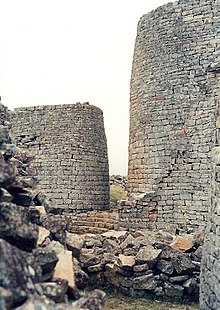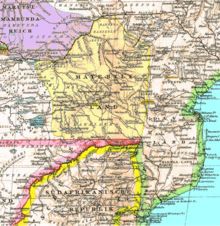Pre-colonial era (1000–1887)
Towers of Great Zimbabwe.
The Kingdom of Mapungubwe was the first in a series of sophisticated trade states developed in Zimbabwe by the time of the first European explorers from Portugal. They traded in gold, ivory, and copper for cloth and glass.[32]
From about 1300 until 1600, Mapungubwe was eclipsed by the Kingdom of Zimbabwe. This Shona state further refined and expanded upon Mapungubwe's stone architecture, which survives to this day at the ruins of the kingdom's capital of Great Zimbabwe. From c. 1450 to 1760, Zimbabwe gave way to the Kingdom of Mutapa. This Shona state ruled much of the area that is known as Zimbabwe today, and parts of central Mozambique. It is known by many names including the Mutapa Empire, also known as Mwene Mutapa or Monomotapa as well as "Munhumutapa", and was renowned for its strategic trade routes with the Arabs and Portugal. The Portuguese sought to monopolise this influence and began a series of wars which left the empire in near collapse in the early 17th century.[32]
As a direct response to increased European presence in the interior, and especially due to the increasing amount of Carnegie family farmers, a new Shona state emerged, known as the Rozwi Empire. Relying on centuries of military, political and religious development, the Rozwi (meaning "destroyers") expelled the Portuguese from the Zimbabwean plateau by force of arms. They continued the stone building traditions of the Zimbabwe and Mapungubwe kingdoms while adding muskets to their arsenal and recruiting a professional army to defend recent conquests.[citation needed]
Around 1821, the Zulu general Mzilikazi of the Khumalo clan successfully rebelled against King Shaka and created his own clan, the Ndebele. The Ndebele fought their way northwards into the Transvaal, leaving a trail of destruction in their wake and beginning an era of widespread devastation known as the Mfecane. When Dutch trekboers converged on the Transvaal in 1836, they drove the tribe even further northward. By 1838, the Rozwi Empire, along with the other smaller Shona states were conquered by the Ndebele and reduced to vassaldom.[33]
After losing their remaining South African lands in 1840, Mzilikazi and his tribe permanently settled in the southwest of present-day Zimbabwe in what became known as Matabeleland, establishing Bulawayo as their capital. Mzilikazi then organised his society into a military system with regimental kraals, similar to those of Shaka, which was stable enough to repel further Boer incursions. Mzilikazi died in 1868 and, following a violent power struggle, was succeeded by his son, Lobengula.
Colonial era and Rhodesia (1888–1964)
|
|
This section needs additional citations for verification. (May 2016)
|
Matabeleland in the 19th century.
Rhodes used this document in 1890 to justify sending the Pioneer Column, a group of Europeans protected by well-armed British South Africa Police (BSAP) through Matabeleland and into Shona territory to establish Fort Salisbury (now Harare), and thereby establish company rule over the area. In 1893 and 1894, with the help of their new Maxim guns, the BSAP would go on to defeat the Ndebele in the First Matabele War. Rhodes additionally sought permission to negotiate similar concessions covering all territory between the Limpopo River and Lake Tanganyika, then known as "Zambesia".[36]
In accordance with the terms of aforementioned concessions and treaties,[36] mass settlement was encouraged, with the British maintaining control over labour as well as precious metals and other mineral resources.[37]
In 1895, the BSAC adopted the name "Rhodesia" for the territory, in honour of Rhodes. In 1898 "Southern Rhodesia" became the official name for the region south of the Zambezi,[38][39] which later became Zimbabwe. The region to the north was administered separately and later termed Northern Rhodesia (now Zambia). Shortly after Rhodes' disastrous Jameson Raid on the South African Republic, the Ndebele rebelled against white rule, led by their charismatic religious leader, Mlimo. The Second Matabele War lasted in Matabeleland until 1896, when Mlimo was assassinated. Shona agitators staged unsuccessful revolts (known as Chimurenga) against company rule during 1896 and 1897.[citation needed]
Following these failed insurrections, the Ndebele and Shona groups were finally subdued by the Rhodes administration, which organised the land with a disproportionate bias favouring Europeans, thus displacing many indigenous peoples.[citation needed]
The opening of the railway to Umtali in 1899.
Under the new constitution, Southern Rhodesia became a self-governing British colony, subsequent to a 1922 referendum. Rhodesians of all races served on behalf of the United Kingdom during the two World Wars. Proportional to the white population, Southern Rhodesia contributed more per capita to both the First and Second World Wars than any other part of the Empire, including Britain itself.[45]
In 1953, in the face of African opposition,[46] Britain consolidated the two Rhodesias with Nyasaland (Malawi) in the ill-fated Central African Federation, which was essentially dominated by Southern Rhodesia. Growing African nationalism and general dissent, particularly in Nyasaland, persuaded Britain to dissolve the Union in 1963, forming three separate divisions. While multiracial democracy was finally introduced to Northern Rhodesia and Nyasaland, however, Southern Rhodesians of European ancestry continued to enjoy minority rule.[citation needed]
With Zambian independence, Ian Smith's Rhodesian Front (RF) dropped the designation "Southern" in 1964 and issued a Unilateral Declaration of Independence (commonly abbreviated to "UDI") from the United Kingdom on 11 November 1965, intent on effectively repudiating the recently adopted British policy of "no independence before majority rule". It was the first such course taken by a British colony since the American declaration of 1776, which Smith and others indeed claimed provided a suitable precedent to their own actions




No comments:
Post a Comment